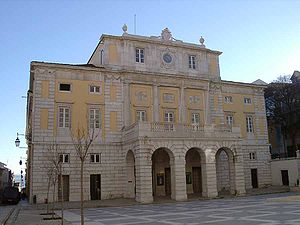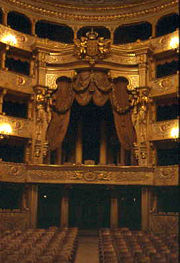
Teatro Nacional de São Carlos
Encyclopedia

Opera house
An opera house is a theatre building used for opera performances that consists of a stage, an orchestra pit, audience seating, and backstage facilities for costumes and set building...
in Lisbon
Lisbon
Lisbon is the capital city and largest city of Portugal with a population of 545,245 within its administrative limits on a land area of . The urban area of Lisbon extends beyond the administrative city limits with a population of 3 million on an area of , making it the 9th most populous urban...
, Portugal
Portugal
Portugal , officially the Portuguese Republic is a country situated in southwestern Europe on the Iberian Peninsula. Portugal is the westernmost country of Europe, and is bordered by the Atlantic Ocean to the West and South and by Spain to the North and East. The Atlantic archipelagos of the...
. It was opened on July 30, 1793 by Queen Maria I
Maria I of Portugal
Maria I was Queen regnant of Portugal and the Algarves from 1777 until her death. Known as Maria the Pious , or Maria the Mad , she was the first undisputed Queen regnant of Portugal...
as a replacement for the Tejo Opera House, which was destroyed in the 1755 Lisbon earthquake
1755 Lisbon earthquake
The 1755 Lisbon earthquake, also known as the Great Lisbon Earthquake, was a megathrust earthquake that took place on Saturday 1 November 1755, at around 9:40 in the morning. The earthquake was followed by fires and a tsunami, which almost totally destroyed Lisbon in the Kingdom of Portugal, and...
. The theatre is located in the historical center of Lisbon, in the Chiado district
Chiado
Chiado is the name of a square and its surrounding area in the city of Lisbon, in Portugal. The Chiado is located between the neighbourhoods of Bairro Alto and Baixa Pombalina....
.
In 1792, a group of Lisbon businessmen decided to finance the construction of a new Opera House in the city. The theatre was built in only six months following a design by Portuguese architect José da Costa e Silva
José da Costa e Silva
José da Costa e Silva was a Portuguese architect. His work helped establish Neoclassical architecture in Portugal and colonial Brazil....
, with neoclassical
Neoclassical architecture
Neoclassical architecture was an architectural style produced by the neoclassical movement that began in the mid-18th century, manifested both in its details as a reaction against the Rococo style of naturalistic ornament, and in its architectural formulas as an outgrowth of some classicizing...
and rococo
Rococo
Rococo , also referred to as "Late Baroque", is an 18th-century style which developed as Baroque artists gave up their symmetry and became increasingly ornate, florid, and playful...
elements. The general project is clearly inspired by great Italian theatres like the San Carlo
San Carlo
San Carlo is the Italian for Saint Charles, and may refer to:* Charles Borromeo, also known as San Carlo Borromeo* San Carlo all'Arena, a neighbourhood in Naples where the Bourbon Hospice for the Poor is located...
of Naples
Naples
Naples is a city in Southern Italy, situated on the country's west coast by the Gulf of Naples. Lying between two notable volcanic regions, Mount Vesuvius and the Phlegraean Fields, it is the capital of the region of Campania and of the province of Naples...
(interior) and La Scala
La Scala
La Scala , is a world renowned opera house in Milan, Italy. The theatre was inaugurated on 3 August 1778 and was originally known as the New Royal-Ducal Theatre at La Scala...
in Milan
Milan
Milan is the second-largest city in Italy and the capital city of the region of Lombardy and of the province of Milan. The city proper has a population of about 1.3 million, while its urban area, roughly coinciding with its administrative province and the bordering Province of Monza and Brianza ,...
(interior and façade). In the early 19th century, when the Portuguese Royal Court had to flee to Brazil
Brazil
Brazil , officially the Federative Republic of Brazil , is the largest country in South America. It is the world's fifth largest country, both by geographical area and by population with over 192 million people...
to escape the invading Napoleonic troops
Peninsular War
The Peninsular War was a war between France and the allied powers of Spain, the United Kingdom, and Portugal for control of the Iberian Peninsula during the Napoleonic Wars. The war began when French and Spanish armies crossed Spain and invaded Portugal in 1807. Then, in 1808, France turned on its...
, a theatre modelled on the São Carlos was built in Rio de Janeiro
Rio de Janeiro
Rio de Janeiro , commonly referred to simply as Rio, is the capital city of the State of Rio de Janeiro, the second largest city of Brazil, and the third largest metropolitan area and agglomeration in South America, boasting approximately 6.3 million people within the city proper, making it the 6th...
.

Portico
A portico is a porch leading to the entrance of a building, or extended as a colonnade, with a roof structure over a walkway, supported by columns or enclosed by walls...
). The theatre was named after the Princess Charlotte of Spain
Charlotte of Spain
Doña Carlota Joaquina of Spain was a Queen consort of Portugal as wife of John VI...
, who had come to Portugal in 1790 to marry the future King, Prince John
John VI of Portugal
John VI John VI John VI (full name: João Maria José Francisco Xavier de Paula Luís António Domingos Rafael; (13 May 1767 – 10 March 1826) was King of the United Kingdom of Portugal, Brazil and the Algarves (later changed to just King of Portugal and the Algarves, after Brazil was recognized...
: Carlos (Portuguese form of Charles) is the masculine form of Charlotte.
A Latin
Latin
Latin is an Italic language originally spoken in Latium and Ancient Rome. It, along with most European languages, is a descendant of the ancient Proto-Indo-European language. Although it is considered a dead language, a number of scholars and members of the Christian clergy speak it fluently, and...
commemorative inscription dedicates the theatre to the princess.
The beautiful main room is elliptic, has five tiers of boxes and seats 1148 people. The luxurious royal box was lavishly decorated by the Italian Giovanni Appianni. The ceiling was painted by Manuel da Costa and the stage by Cirilo Wolkmar Machado.
The first opera presented here, in 1793, was La Ballerina Amante, by Domenico Cimarosa
Domenico Cimarosa
Domenico Cimarosa was an Italian opera composer of the Neapolitan school...
. The most famous Portuguese composer of the time, Marcos Portugal
Marcos Portugal
Marcos António da Fonseca Portugal was a Portuguese classical composer, who achieved great international fame for his operas in Italian....
, became musical director of the São Carlos in 1800 after returning from Italy, and many of his operas were staged here.
Between 1828 and 1834, the São Carlos was closed due to the Portuguese Civil War, fought between kings Miguel I and Pedro IV. In 1850, the lighting of the interior was changed to gas illumination
Gas lighting
Gas lighting is production of artificial light from combustion of a gaseous fuel, including hydrogen, methane, carbon monoxide, propane, butane, acetylene, ethylene, or natural gas. Before electricity became sufficiently widespread and economical to allow for general public use, gas was the most...
, the latest technology available. Shortly afterwards, the Portuguese state bought the theatre from private investors
Investment
Investment has different meanings in finance and economics. Finance investment is putting money into something with the expectation of gain, that upon thorough analysis, has a high degree of security for the principal amount, as well as security of return, within an expected period of time...
. After a few failed attempts, electrical illumination
Stage lighting
Modern stage lighting is a flexible tool in the production of theatre, dance, opera and other performance arts. Several different types of stage lighting instruments are used in the pursuit of the various principles or goals of lighting. Stage lighting has grown considerably in recent years...
was installed in 1887. From 1935 to 1940, the theatre was closed for repairs. In 1974 a resident opera company was established. In 1993, the Orquestra Sinfónica Portuguesa was created as the Teatro's affiliate orchestra.
Since 2010, the artistic director of the Teatro Nacional de São Carlos is Martin André. Since 2008, the principal conductor of the Orquestra Sinfónica Portuguesa is Julia Jones
Julia Jones (conductor)
Julia Jones is an English conductor.Jones grew up on the Isle of Man, and attended the Chetham's School of Music, where she studied piano, clarinet, and singing. She continued her music studies at the University of Bristol, in conducting, piano, clarinet, and harpsichord, completing her B.A....
.

